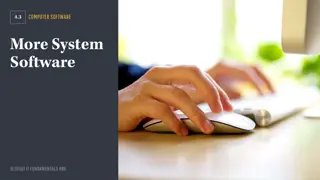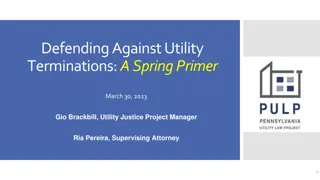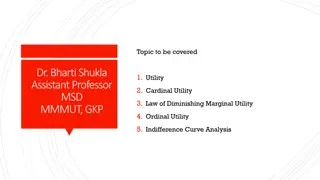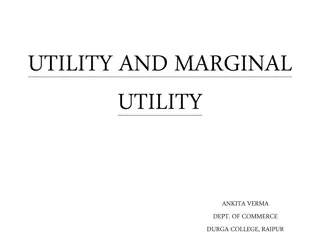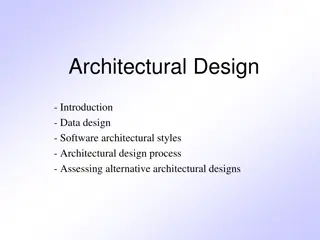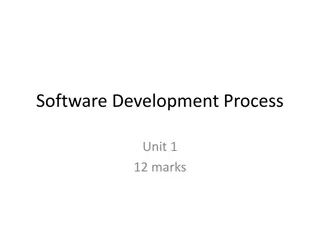Understanding Utility Software in IT Systems
Utility software plays a crucial role in maintaining and configuring computer systems. This unit focuses on key utility software types like defragmentation, backups, compression, anti-virus, and encryption. Understanding the purpose, features, advantages, and disadvantages of utility software is essential for effective computer system management and data protection. Learn about defragmentation, backups, and incremental vs. full backups to enhance your knowledge of utility software utilization.
Uploaded on Jul 10, 2024 | 0 Views
Download Presentation

Please find below an Image/Link to download the presentation.
The content on the website is provided AS IS for your information and personal use only. It may not be sold, licensed, or shared on other websites without obtaining consent from the author. Download presentation by click this link. If you encounter any issues during the download, it is possible that the publisher has removed the file from their server.
E N D
Presentation Transcript
Cambridge Technicals Level 3 IT Unit 1: Fundamentals of IT Utility Software Utility Software LO2: Understand Computer Software
Wednesday, 10 July 2024 Wednesday, 10 July 2024 Utility Software Utility Software Cambridge Technicals Level 3 IT Unit 1: Fundamentals of IT Learning Objective: To be able to demonstrate an understanding of how utility software is used in a computer system. Success Criteria: 1. I can describe the purpose of different utility software. 2. I can identify and explain key features and functions of different utility software. 3. I can evaluate the advantages and disadvantages of each.
Cambridge Technicals Level 3 IT Unit 1: Fundamentals of IT What is Utility Software? What is Utility Software? Utility system software helps to maintain or configure a computer. Many useful utilities are installed with the operating system, but extra utility software can be installed to perform additional tasks. We are going to focus on the following types of utility software: Defragmentation Backups Compression Anti-virus Encryption
Cambridge Technicals Level 3 IT Unit 1: Fundamentals of IT Defragmentation Defragmentation 1) Files are stored on a hard disk in available spaces. Ideally, entire files would be stored together. 2) However as files are moved, deleted and change size, lots of small gaps begin to appear on the disk. When writing files to the disk, the OS splits files into smaller blocks to fill up the gaps. 3) Over time, the disk becomes more and more fragmented. This makes reading and writing files slower as the read/write head has to move back and forth across the disk. 4) Defragmentation software reorganises data on the hard drive to put fragmented files back together. It also moves files to collect all the free space together. This helps prevent further fragmentation. Each colour is a file Gaps appear New file (grey) split into blocks Blocks collected Gaps collected Files deleted New file added Data on HDD After defragmentation Note: As SSDs use flash storage with no moving parts, fragmentation doesn t cause any problems as they can access data just as quickly however its arranged.
Backups Backups Select what files to backup Cambridge Technicals Level 3 IT Unit 1: Fundamentals of IT Where you can recover data from a previous backup A backup is a copy of a computer system s files and settings stored externally. This means data can be recovered in the event of data loss. Data loss can happen for many reasons: fire theft flood malware hardware failure just accidentally deleting a file. Where you can schedule your backups Incremental Backup: A backup of all changed and new files since the last backup. A backup utility is software with facilities such as scheduling of regular backups, creating rescue disks, disk images and options to have either full or incremental backups. set of data. Full Backup: A backup of all files in a specified
Compression Compression Cambridge Technicals Level 3 IT Unit 1: Fundamentals of IT Compression software reduces the size of files so they take up less disk space. It s used a lot on the internet to make files quicker to download. Standard file formats include .zip and .rar Compressed files need to be extracted before they can be used. You can purchase/download software that deals with file compression, but most operating systems have this built in.
Did you know? There are on average 82,000 new viruses written every day. Cambridge Technicals Level 3 IT Unit 1: Fundamentals of IT Anti Anti- -Virus/Malware Software Virus/Malware Software Anti-Malware software is designed to find and stop malware from damaging a network and the devices on it. There are lots of different types of anti- malware software, including anti-virus programs which isolate and destroy computer viruses. This is why your anti- virus software updates daily. Every time a new virus is discovered it is stored in a virus database so that your software knows to look for this one as well when running scans. Fact: Nearly seven out of ten attacks on all firms involved viruses, spyware or malware (.gov UK)
Cambridge Technicals Level 3 IT Unit 1: Fundamentals of IT Encryption Software Encryption Software Encryption scrambles data in such a way that only a person or computer with the right software key can read it. Much of the data that we send across the internet is encrypted by software already built into the browser. An encryption utility can be used to secure data. The file is selected, a password created ad the encryption utility encrypts the data within that file. In order to decrypt that data, the correct password must be entered. Otherwise someone else opening that file would be scrambled/jibberish data.
Cambridge Technicals Level 3 IT Unit 1: Fundamentals of IT Exam Question Practise Exam Question Practise 1) Explain the difference between a full and incremental backup. [2 Marks] 2) Explain how data encryption software works. [3 marks] 3) Describe how defragmentation works. [4 Marks]




